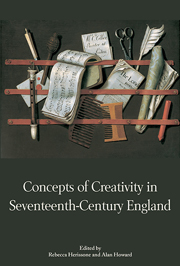Book contents
- Frontmatter
- Contents
- List of Illustrations
- List of Contributors
- Preface
- Introduction
- Creating to Order: Patronage and the Creative Act
- Creative Identity and the Role of Print Media
- Mapping Knowledge: The Visual Representation of Ideas
- 5 Space, Text and Creativity in the Late Sixteenth and Seventeenth Centuries
- 6 The ‘Artificial Sceane’: The Re-creation of Italian Architecture in John Evelyn's Diary
- Authorial Identity
- Imitation and Arrangement
- The Performer as Creator
- Bibliography
- Index
6 - The ‘Artificial Sceane’: The Re-creation of Italian Architecture in John Evelyn's Diary
from Mapping Knowledge: The Visual Representation of Ideas
Published online by Cambridge University Press: 05 March 2014
- Frontmatter
- Contents
- List of Illustrations
- List of Contributors
- Preface
- Introduction
- Creating to Order: Patronage and the Creative Act
- Creative Identity and the Role of Print Media
- Mapping Knowledge: The Visual Representation of Ideas
- 5 Space, Text and Creativity in the Late Sixteenth and Seventeenth Centuries
- 6 The ‘Artificial Sceane’: The Re-creation of Italian Architecture in John Evelyn's Diary
- Authorial Identity
- Imitation and Arrangement
- The Performer as Creator
- Bibliography
- Index
Summary
This essay grows from a concern with the old art-historical problem of how the perception of art, or in this case more specifically architecture, changes over time. It sets out to explore how verbal representations preserve clues about such changes in the way we see the world, while proposing that the dialogue between subject and object is perhaps more palpable in texts than it is in pictures. The protagonist is seventeenth-century diarist John Evelyn, who travelled in Italy between 1644 and 1646. The account of this journey forms part of his seminal Diary, which he compiled mainly retrospectively from the 1660s onwards. One of the main seventeenth-century English sources for historians of all fields and by some even regarded as having changed travel writing, Evelyn is nevertheless well known for having copied generous parts of his text from earlier guidebooks.2 In the following I will try to dismantle sentence by sentence one short passage in which he describes the city of Genoa. Comparing his text to other seventeenth-century guidebooks allows us to see not only what Evelyn copied, but also what he altered, what he added, and, more importantly, what these alterations and additions tell us about contemporary modes of perception and representation. The ensuing analysis raises questions about concepts of creativity and originality in the period while probing the ordering of vision and knowledge in the seventeenth century.
- Type
- Chapter
- Information
- Concepts of Creativity in Seventeenth-Century England , pp. 131 - 148Publisher: Boydell & BrewerPrint publication year: 2013



